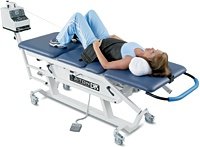Computerized Traction
The New Way to Treat Herniated Discs Without Surgery
 The computerized traction head on the decompression table or machine is the key to the therapy’s effectiveness. The preprogrammed patterns for ramping up and down the amount of axial distraction eliminate muscle guarding and permit decompression to occur at the disc level. This creates a negative pressure within the disc, allowing the protruded or herniated portion to be pulled back within the normal confines of the disc, which permits healing to occur.
The computerized traction head on the decompression table or machine is the key to the therapy’s effectiveness. The preprogrammed patterns for ramping up and down the amount of axial distraction eliminate muscle guarding and permit decompression to occur at the disc level. This creates a negative pressure within the disc, allowing the protruded or herniated portion to be pulled back within the normal confines of the disc, which permits healing to occur.
Your specific treatment plan will be determined by the doctor after your examination. Based on research and my clinical experience, the best results are achieved with 20 sessions over a six-week period. To reduce inflammation and assist the healing process, supporting structures sometimes are treated with passive therapies (cold laser therapy/muscle stimulation/diathermy), chiropractic adjustments (when indicated) and/or active rehabilitation in order to strengthen the spinal musculature.
Spinal decompression therapy has saved many people from spinal surgery. If you are suffering from a degenerated or herniated disc, I encourage you to explore safe and effective spinal decompression therapy before risking surgery. The rationale for treating a herniated disc without resorting to surgery has research support on its side: According to a recent study in the Journal of the American Medical Association, surgery is no more effective than non-invasive treatments, including chiropractic care, for patients with lumbar disc herniati causing sciatica.
Here’s a brief explanation of what these terms mean in relation to your spine.
Anulus Fibrosus: The tough outer ring of a vertebral disc; it encases the nucleus pulposus (see description below) within the disc.
Facet Syndrome: An irritation of one or more of the joints on the back of the spinal vertebrae, which comprise the spinal column.
Herniated Disc: Displacement of the center of a vertebral disc through a crack in the outer layer. Disc herniation can put pressure on spinal nerves and cause pain.
Muscle Guarding: Muscle spasming, often in response to a painful stimulus.
Nucleus Pulposus: A gel-like substance within each intervertebral disc, surrounded by the anulus fibrosus.
Sciatica: Pain in the lower back, buttocks, hips, or adjacent anatomical structures, frequently attributable to spinal dysfunction.
Spinal Stenosis: Narrowing of the spine at one or more of three locations: in the center of the spine, where nerves branch from the spine, or in the space between vertebrae. This puts pressure on spinal nerves and can cause pain.
Spondylosis: Otherwise known as spinal arthritis, spondylosis is a degenerative condition in which spinal discs weaken, particularly with age.
We're conveniently located in Gadsden, Alabama